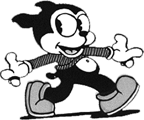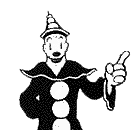The Birth of Betty
 The first appearance of Betty Boop was in the 6th Talkartoon starring Bimbo, entitled "Dizzy Dishes" (1930.). Grim Natwick was the first animator to draw Betty, who had not yet been officially named. He took inspiration for Betty's spit curls from a song sheet of Helen Kane, commonly called the "Boop Oop a Doop Girl". Betty started out being designed as a human-like dog, only her black button nose and floppy ears hinting at her canine nature. These ears later became her round earrings, in part due to the fact that the Fleischer animators had a tendency to change animating styles and features of characters from cartoon to cartoon, and sometimes within the same cartoon. (In "Bum Bandit"-1931- Betty's nose changes from black to white and then back again in the same cartoon.) Her high baby voice, like her spit curls, were in imitation of singer Helen Kane. Her first starring role was in "Betty Coed" (1931), which also marked the first time the name Betty was connected with the character. In "Any Rags" (1932), Betty became completely human, and her ears permanently became earrings. As for her famous garter, Betty started out with two, then early drawings showing her still with ears show the garter on her right leg. When she became a regular, however, and her features were officially set, the garter moved to her left leg, and stayed there.
The first appearance of Betty Boop was in the 6th Talkartoon starring Bimbo, entitled "Dizzy Dishes" (1930.). Grim Natwick was the first animator to draw Betty, who had not yet been officially named. He took inspiration for Betty's spit curls from a song sheet of Helen Kane, commonly called the "Boop Oop a Doop Girl". Betty started out being designed as a human-like dog, only her black button nose and floppy ears hinting at her canine nature. These ears later became her round earrings, in part due to the fact that the Fleischer animators had a tendency to change animating styles and features of characters from cartoon to cartoon, and sometimes within the same cartoon. (In "Bum Bandit"-1931- Betty's nose changes from black to white and then back again in the same cartoon.) Her high baby voice, like her spit curls, were in imitation of singer Helen Kane. Her first starring role was in "Betty Coed" (1931), which also marked the first time the name Betty was connected with the character. In "Any Rags" (1932), Betty became completely human, and her ears permanently became earrings. As for her famous garter, Betty started out with two, then early drawings showing her still with ears show the garter on her right leg. When she became a regular, however, and her features were officially set, the garter moved to her left leg, and stayed there.
Betty's Return
Betty's series ended in 1939 with "Yip Yip Yippy". In the years to follow, she would appear in clumsily colored re-releases (1970) on television, but her real revival came about during the late 60's and early 70's, when her cartoons began to appear in late night showings at college town theaters, as well as part of psychedelic light shows. Since then she has remained popular, with a fan following that becomes larger every day. The 90's celebration of her 60th anniversary brought her back into the public eye even more. To commemorate the event, A&E did a Biography special on her and on the Fleischers, and the American Movie Classics channel (AMC) has shown several of her cartoons. Her cartoons are now available to the general public in an 8 tape set from Republic Pictures.
 Betty's Strip
Betty's Strip
In 1934, Betty began appearing in comic strips drawn by Bud Counihan (though they were signed with Max Fleischer's name.) The daily strip ran for one year (1934-1935), then was released only on Sundays until 1937. Appearing with Betty in the strips were a whole cast of regulars, who never made it to the big screen. Several were caricatures of male stars of the time, including Van Twinkle (A dark haired man with a cane and a fancy cigarette holder. Van Twinkle had a baby brother named Percy who was the same age as Billy, Betty's little brother.), Van Arsdale (a moustached star), Van Hart (a blonde), and Val Velour were a few. More regularly appearing were Von Script (Betty's director), Aunt Tillie (A large woman with a quick and violent temper, and tattoos of anchors on her forearms) and Betty's baby brother called Billy or, (when he lost the baby bonnet and grew a little hair) Bubby or Bobby.
The plotlines in general followed Betty's adventures as an actress, as well as her dealings with her temperamental little brother and his acting career. Another character featured in the strips, never seen but often mentioned, was "The Chief", from whom Betty and her director took their orders. Pudgy appeared in several strips as a generic dog, or "Hugo" or "Spunky", but never Pudgy. Also shown during contract disputes were Betty's lawyers, a group of four double chinned and balding, bespectacled men. (These collected strips are available in Betty Boop's Hollywood Chronicles, Avon Books, New York.)
 Betty's Friends
Betty's Friends
In 1932 Betty took over as the Fleischer star, and Bimbo was relegated to the role of her companion. He didn't seem to mind, even when she stopped being a dog and became human. Other regular co-stars included Ko-Ko the clown, who had been retired for some years from his previous cartoon series, and Pudgy, her faithful puppy companion (created by Myron Waldman). Also seen in many cartoons with Betty were Grampy (who appeared in over 10 Betty cartoons), and the pretty boy Freddy, her sometime love interest, as well as a host of other personified animals (most of whom disappeared after 1934). Only appearing once with Betty were Henry, the Little King and Little Jimmy, all adopted from other cartoon strips. As for romantic connection, she was seen not only with Freddy, but also with Bimbo on a regular basis, and Ko-Ko, with slightly less regularity. Ko-Ko was occasionally given the singing voice and dance moves of Cab Calloway during his guest appearances.
Betty's Voice
Among those who provided Betty's voice were Margie Hines, Kate Wright, Bonnie Poe, Mae Questel and Annabel Little. Ann was the first to be chosen, and made a few cartoons before taking Betty on the road in a vaudeville act. Mae Questel was in her teens when she won a Helen Kane look alike contest, and was hired by Paramount, who had Kane's contract, to appear in the RKO chain of theaters for publicity. In 1931, Max Fleischer saw Mae and invited her to do Betty's voice, which she did until the series ended in 1939.
Many other star voices appeared in Betty cartoons, among them Rudy Vallee (Rudy Valee Memories), Louis Armstrong ("I'll Be Glad When You're Dead, You Rascal You") and Cab Calloway ("Minnie The Moocher", "Snow White" and "Old Man of the Mountain") .
 Betty's Sex Appeal
Betty's Sex Appeal
Unlike Disney, Fleischer Studios' only real competitor at the time, Fleischer allowed several racy images and scenarios to enter his cartoons. In several cartoons, Betty loses the top of her dress ("Any Rags"-1932 and "Poor Cinderella"-1934), exposing a frilly strapless bra, and in others her skirt flies up ("Dizzy Red Riding Hood"-1931 and "Barnacle Bill"-1930.) You can even catch a glimpse of her breast in "Betty Boop's Rise To Fame", while she changes into her hula outfit, but only if you look quickly (The scene lasts only 1/24th of a second.) In the same picture, she performs the hula dance with only a strategically placed flower lei to cover her chest. In a couple of cartoons ("Mysterious Mose"-1930 and "The Old Man of the Mountain"-1933), Betty loses her dress completely, but is conveniently hidden behind a tree or in her bed. Very often Betty's curved silhouette could be seen through her clothing as she passed before a fire or other light. By 1935, in the era where sitcom married couples slept in separate beds, Betty was toned down. Her skirt was lengthened and her strapless dress given a top and short sleeves. Thankfully, today censors are not so strict, and Betty has returned to her former self.
Betty's Legal Troubles
All was not wine and roses for Betty. In April 1934, Helen Kane, whose popularity had waned since her debut in 1929, filed suit against Max Fleischer, Fleischer Studios and Paramount Pictures for $250,000. She claimed that Betty Boop had stolen her fans. Max Fleischer gave testimony that Betty Boop was not based on Helen Kane (which was untrue - Kane was one of the main inspirations for Betty, though she developed other features on her own as the years progressed.) Five of the women who had been the voice for Betty Boop appeared in court to deny that they had attempted to imitate Kane's voice. The judge even watched and compared several of Betty's cartoons with some of Helen Kane's films. There was testimony that the "Boop Oop a Doop" phrase came long before Kane's popularity, as one witness claimed to have heard the phrase uttered in an Edith Griffith song. And on May 2nd, Paramount Pictures was able to locate a film clip of another singer, Baby Esther, who used the same phrase in a song in 1928.
Betty Today
The first Boopabelia hit the stores in 1934, decorating such items as coats, tea sets, cards, dolls and watches with her now familiar image. Today, you can find anything from t-shirts and shower curtains, to personalized checks and nail polish, each bearing Betty's charming likeness. A new line of Betty Boop dolls from Precious Kids has just been released, including some talking dolls. Her cartoons have been released and re-released, and her complete set of cartoons is now available in an 8 tape set, celebrating her 60th year, (available at any major movie retailer, and Amazon.com.) She remains popular in Europe and in Mexico, as well as other places around the world. With her round wide eyes and her pouty mouth, she has boop-oop-a-dooped her way into the hearts of hundreds, or even thousands.
|
